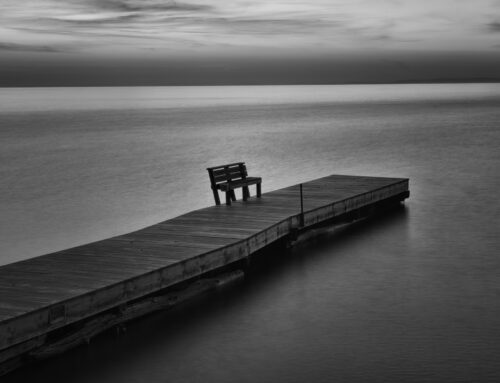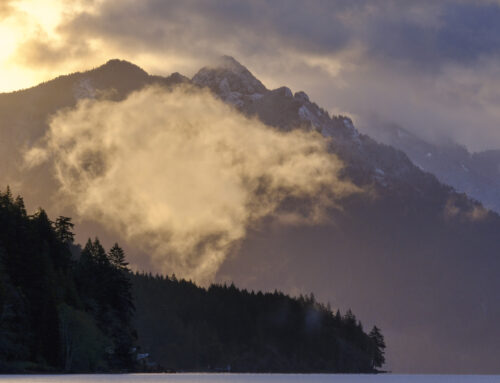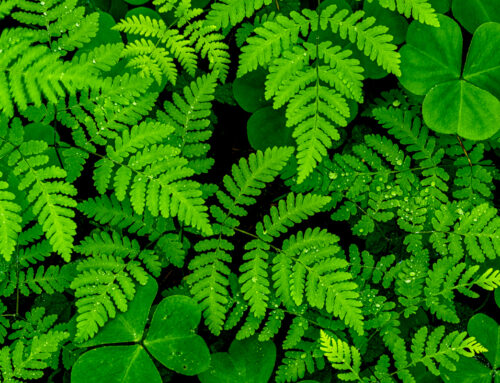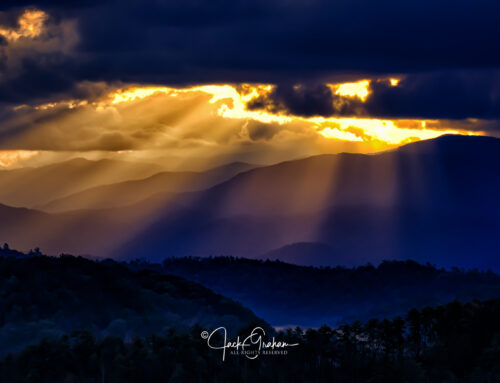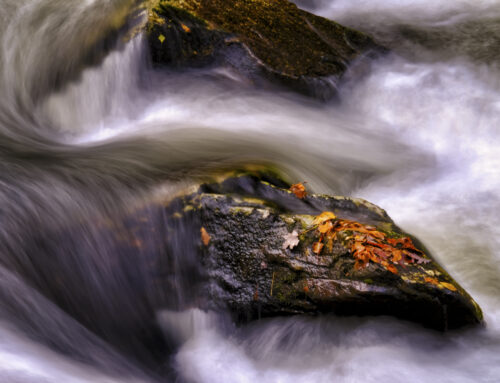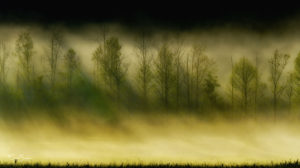
First let me be clear. These are just my observations and thoughts. Please understand this as you read on. I see hundreds of workshop attendees every year. I review thousands of images. I see many great ones, many good ones, some bad ones and sometimes the downright ugly ones (few and far between thankfully). However, lots of what I see is subjective art which was in the mind of the photographers as they made the photograph. What is good or bad is not up to me, it’s up to the one making the art.
Having said that, there are bounds I have set for myself and some I still wrestle with every day. I guess to paraphrase some other great photographers my attitude is “Do what you want, just let us know if its manipulated and to what extent… say what you did”. Think about it. Many images we enjoy are not realistic depictions of what the photographer was looking at the time that the shutter was engaged. That’s just a fact.
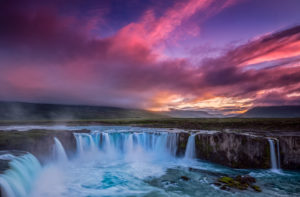 I cannot think of a more polarizing topic that we landscaper photographers face these days. Like so many other discussions that resonate throughout our society these days, manipulation and deception is certainly one that some folks avoid, some reel against, and some that are accepted as the norm.
I cannot think of a more polarizing topic that we landscaper photographers face these days. Like so many other discussions that resonate throughout our society these days, manipulation and deception is certainly one that some folks avoid, some reel against, and some that are accepted as the norm.
Unfortunately, occasionally I see those perfect sunsets on a perfect mountain range, with a perfect elk pointing in just the perfect direction and sometimes close to the camera, with a perfect moon rising behind it. When I do, I usually say to myself “We’ll that didn’t happen!”
If the photographer say’s, here’s how I made this image and fesses up to adding the moon and the elk, I say, “Hay that’s ok, he or she just said how they made this photograph” and it’s all good. However, since I don’t adhere to that kind of deception, I would relegate that photograph to what I call “Photo Art”.
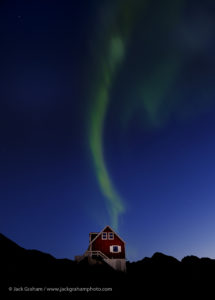 We all have our own standards on what is Photo Art and what is not. One thing I ask you all to remember is Landscape Photography is not Photojournalism! We all manipulate to a certain extent. Below is the definition of MANIPULATION in Merriam Webster’s Dictionary.
We all have our own standards on what is Photo Art and what is not. One thing I ask you all to remember is Landscape Photography is not Photojournalism! We all manipulate to a certain extent. Below is the definition of MANIPULATION in Merriam Webster’s Dictionary.
1: to treat or operate with or as if with the hands or by mechanical means especially in a skillful manner manipulate a pencilmanipulate a machine
2a: to manage or utilize skillfully quantify our data and manipulate it statistically— S. L. Payne
b: to control or play upon by artful, unfair, or insidious means especially to one’s own advantages being used and manipulated by the knowing men around him— New Republic
3: to change by artful or unfair means so as to serve one’s purpose : DOCTORsuspected that the police reports were manipulated— Evelyn G. Cruickshanks
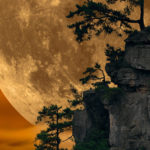 A few years ago, Steve Mc Curry, a noted photographer whose images have been widely featured in National Geographic Magazine came under fire when some of his famous images were found to have elements eliminated or moved. Not too long ago a famous image by fine-art photographer peter Lik was scrutinized over the image of the super moon against a mountainside. This image and controversy blew up on the internet. Finally, it came out it was a composite image, something Lik on his website always denied. Look for that image now—it’s nowhere to be found on Lik’s website. Had he said what he did in the beginning, there would be no controversy. Only lots of footwork by writers and other photographers brought the truth light.
A few years ago, Steve Mc Curry, a noted photographer whose images have been widely featured in National Geographic Magazine came under fire when some of his famous images were found to have elements eliminated or moved. Not too long ago a famous image by fine-art photographer peter Lik was scrutinized over the image of the super moon against a mountainside. This image and controversy blew up on the internet. Finally, it came out it was a composite image, something Lik on his website always denied. Look for that image now—it’s nowhere to be found on Lik’s website. Had he said what he did in the beginning, there would be no controversy. Only lots of footwork by writers and other photographers brought the truth light.
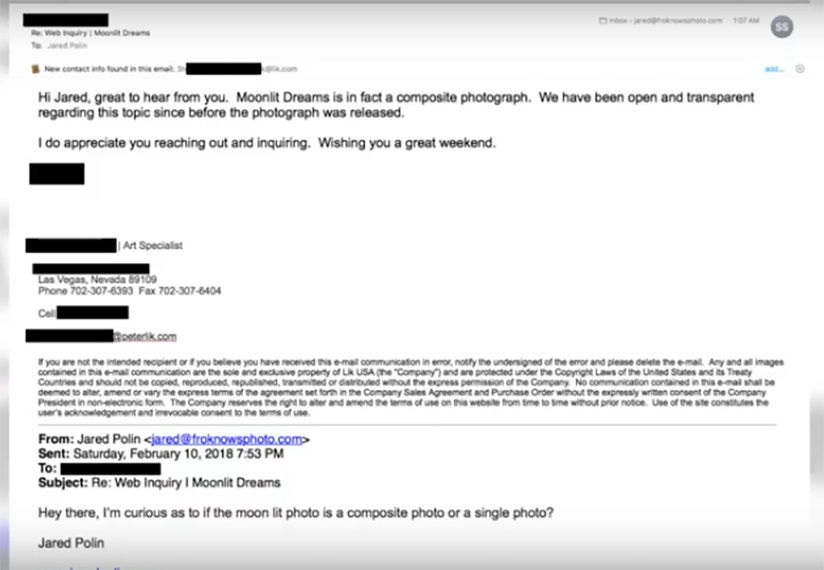
credit www.petapixel.com
I have come to be able to look at photographs as art, not as exact depictions of the conditions, location etc. that was happening when the image was made. I have also been around a long time. I look at things a lot differently than much younger photographers do. Different folks will have different levels of manipulation and or deception goes. I sense that most folks are somewhere in the middle and adhere to the “Say what you did… and it’s OK” theory. I believe the photographer (or the artist!) should be allowed the creative freedom to depict a subject as they wish no matter the extent they go to, to have the results be way they want.
As for myself, I just try and be honest and creative. Isn’t that what art is about. Remember what I do is NOT photojournalism!
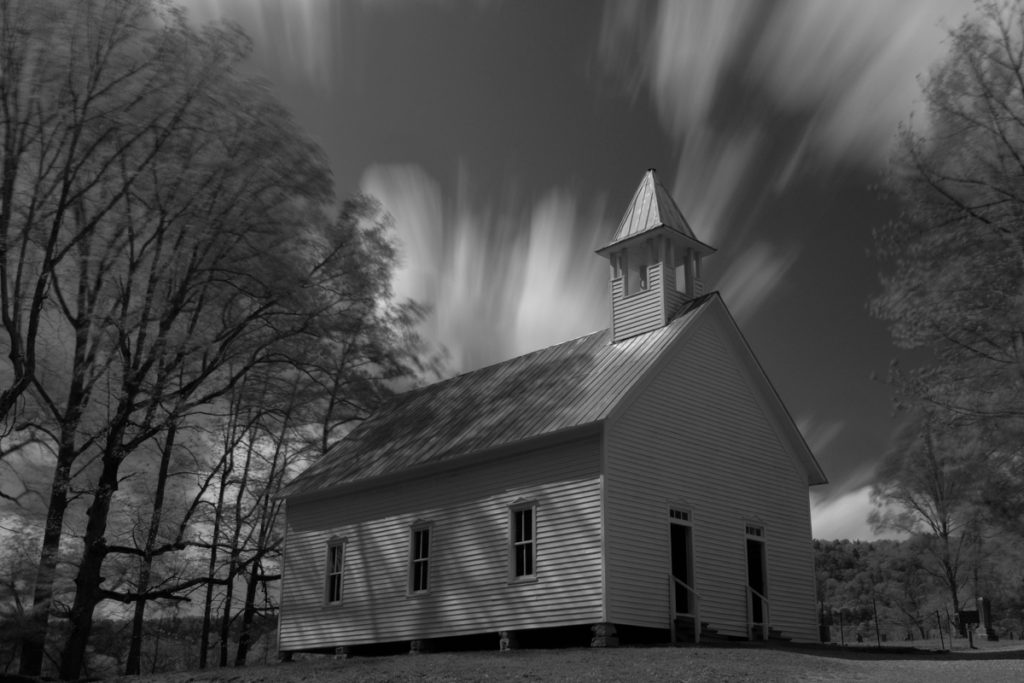
SO, WHAT’S REAL and WHAT’S NOT REAL?… and does that even matter?
Again, we all personally believe we should develop our own bounds for how far we go with our art, always remembering to be willing to explain your interpretation of your image if asked.
Below is a 2 image vertical panorama using a 21 mm lens.
Do we see like this? NO. Do I like it? Yes. Is it what I set out to do? YES
(oh yes—added Orton Effect)
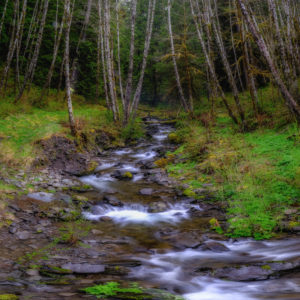 When we say we strive for realism in our photography ask yourself some of the following questions below. I bet you may not consider these when you are in the field, making the photographs, and consider the photograph you’re making to be real.
When we say we strive for realism in our photography ask yourself some of the following questions below. I bet you may not consider these when you are in the field, making the photographs, and consider the photograph you’re making to be real.
- The wide-angle lens— is that reality? Do we see at 20mm through our eyes? The answer is NO.
- We use graduated filters to darken the sky and control light in the foreground. Realistic?
- Some folks like sun stars (using the f22 effect) Realistic?
- With sensor technology and camera tech, we can now see into the shadows that not too long ago were completely black. Realistic?
- Remember the highly saturated films back in the 1990? Realistic?
- I like the silky water affect. Do you? Realistic?
- How about long-exposures using ND filters? Realistic?
- Camera advancements now make it possible to shoot the night sky and infrared like never. Realistic?
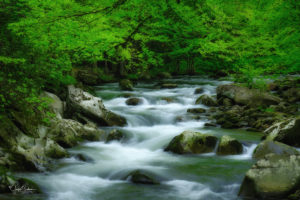
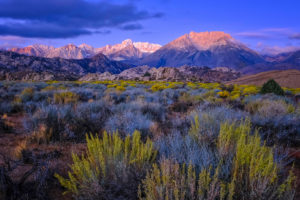
30 second exposure 10 Stop ND 4 stop Graduated ND
BELOW:
12,800 ISO 1/1600–very little noise
(Thank you Fujifilm) 6stop ND Filter + 3 stop Grad
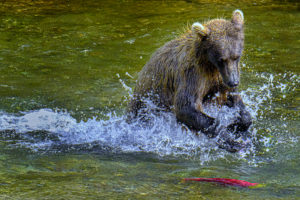
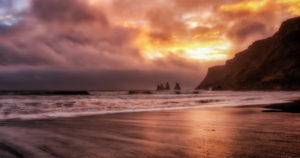
I could go on. My point is that most image we see are not realistic in some sense. Is this wrong? Not at all. But please keep this in mind when you say you are out to make a realistic image of what I say. Ostensibly, we are out there to make “Art” right? I would also suggest to you that you enjoy viewing images as “art” much as possible and avoid not dwelling on how manipulated they may be. Most images are manipulated, either in the field or the darkroom.
EVERY IMAGE, FROM THE INCEPTION OF PHOTOGRAPHY
HAS BEEN PROCESSED ONE WAY OR ANOTHER.
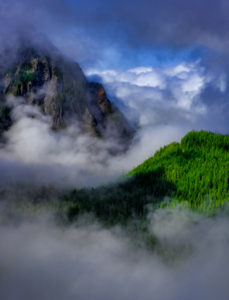 Well that’s kind of not true, not totally. Back before film scanners and processing software, we shot slides (E-6 film). What you had in the slide was what you had. Slide film was unforgiving, and one needed to master exposure or go to the poor house because of the cost of film and processing. As camera and lens technology has progressed into today’s amazing tools, processing, or digital darkroom tools have made deception and manipulation even more of a polarizing topic.
Well that’s kind of not true, not totally. Back before film scanners and processing software, we shot slides (E-6 film). What you had in the slide was what you had. Slide film was unforgiving, and one needed to master exposure or go to the poor house because of the cost of film and processing. As camera and lens technology has progressed into today’s amazing tools, processing, or digital darkroom tools have made deception and manipulation even more of a polarizing topic.
Images that are purposely “over processed” to deceive the viewer is also something that must be addressed. The real discussion however is that we need to attempt to communicate with our viewers if the image itself is depicting a real situation in real time to begin with. It may not.
I always ask myself, is this image made as “art” or as a record of where I was at the time. The vast majority is for art’s sake.
Processing can be the inevitable two-edged sword. For many photographers I know some processing equals a more realistic approach and more processing equals a less real approach.
We are faced with removing objects, cloning in material and cropping images. Again, one needs to develop one’s boundaries and be willing to fess up to how the image was construed.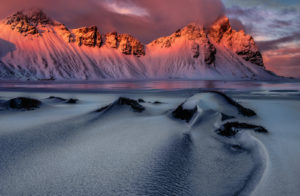
With the new AI (Artificial Intelligence) that is appearing in photo processing software we are going to be faced with decisions like never. Replacing skies, and other features are becoming more commonplace. Its my hope that artists, who use the camera as a tool remember to please be true to the art and when necessary let us know what you did, if anything to make the image look as it is. Remember it’s OK… just let us know. It’s still art.

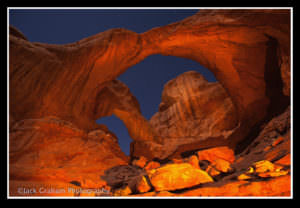
Double”O” Arch, Arches NP light painting !
ONE FINAL THOUGHT
Those of you know me know I have some specific feelings (just mine) about manipulation. Manipulated images are still art, just let us know what you did. For me, my “Art” is trying to attain what I am striving for as much in the camera as possible. This adage is a major portion of what I set out to accomplish when making photographs. When I hear “I bought this 60 MP camera so I can crop half and still have a decent size image” I cringe. Photography, like furniture making, music, cooking, writing etc. is a craft. Please try and learn to treat it that way. If I crop more than 15-20% I personally call my image Photo Art. I don’t add or skies, birds, moons, people. I do remove telephone lines a lot. I do very twigs etc. at times. I don’t do some other things. That’s not to say my work is realistic (remember the silky water etc.). Remember, these are just some of my internal rules. If you want to crop half the image for some reason, go ahead, but please think about striving to be an artist first. Please remember that most images are to a certain extent manipulated already. Look at photographs as art. Oh no I just opened another can of worms!
Text and Images © Jack Graham / All Rights Reserved
Images made with FUJIFLM Cameras AND lenses



